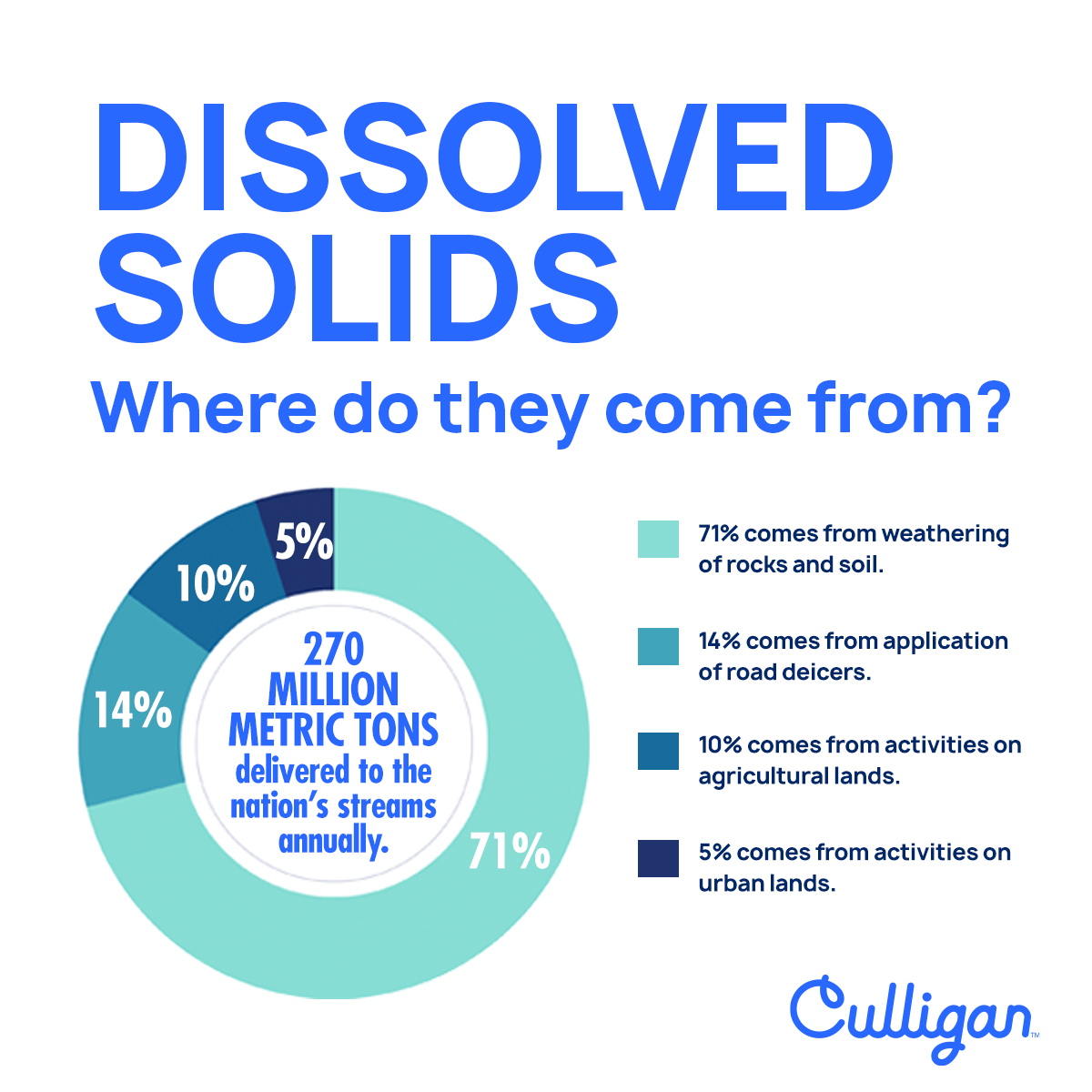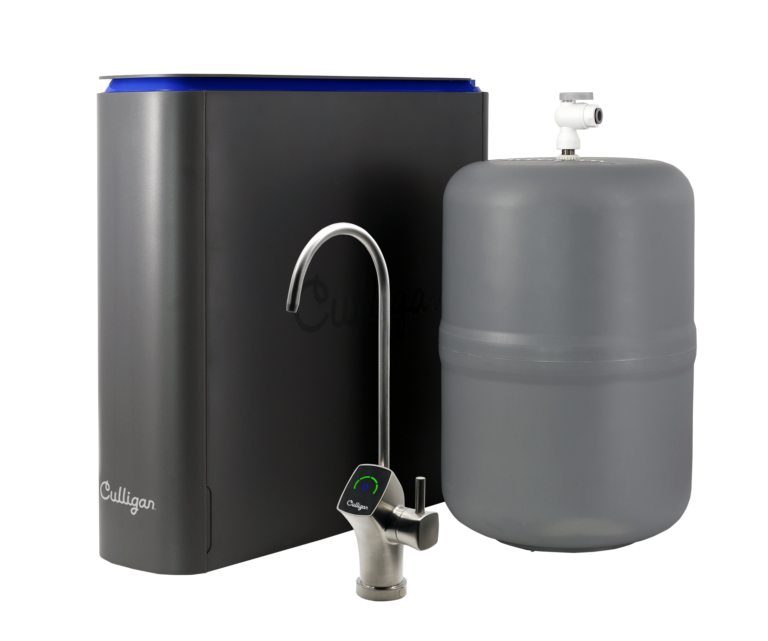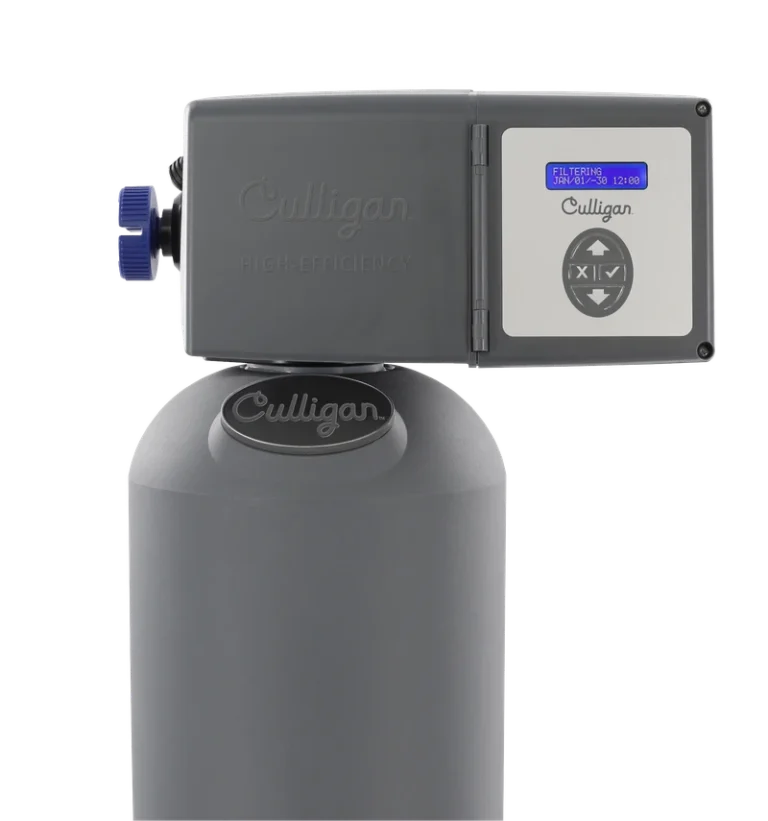How Do Total Dissolved Solids (TDS) Get Into Tampa Water?
The term TDS (Total Dissolved Solids) refers to the cumulative combination of dissolved solids, including cations (positively charged ions) and anions (negatively charged ions), in your water. The level of TDS in water is typically measured in milligrams per liter (mg/L) to assess its impact on water quality. But what does that mean? TDS is the stuff that gets mixed into your water and stays there, kind of like sugar dissolving in coffee. It includes tiny particles with positive or negative charges.
TDS can significantly affect the properties of water, such as taste, salinity level, and the potential for scale formation or corrosion. For example:
- TDS combined with carbonates, such as calcium (CaCO3) or magnesium (MgCO3), can lead to hard water, which causes scale buildup and bitter taste.
- TDS combined with chlorides, such as sodium (NaCl) or potassium (KCl), can result in saline water or brackish water, which often has a salty taste and increased corrosivity.
If you’re concerned about the quality of water in Tampa Bay, consider testing for TDS. While a TDS test will provide the total concentration of dissolved solids, it won’t identify specific compounds.

Why Choose Culligan for TDS Reduction in Tampa?
High levels of Total Dissolved Solids (TDS) can leave your water tasting bitter, corroding plumbing, and reducing the efficiency of appliances. Culligan’s advanced reverse osmosis systems are specifically designed to reduce TDS and improve the overall quality, clarity, and taste of your water. With free water testing and solutions tailored to Tampa’s unique water profile, Culligan helps you take control of your water’s purity—so you can enjoy cleaner, better-tasting water every day.
Solutions
Products to Remove TDS

AC-30® Drinking Water System – 4 Stage Filtration
- Reduces Chromium-6.
- Saves money compared to using single-serve bottles from the store.
- Go green by eliminating wasteful plastic bottles.
- Improve the taste of coffee, tea, powdered drinks, soups, recipes and baby formula.
- Free up valuable refrigerator space by eliminating pitchers and bottled water
- Meets strict standards of NSF International and WQA.
- Third-party certified to perform as promised and are backed by one of the most comprehensive warranties in the industry.
- The Culligan® AC-30 Good Water Machine® is maintenance-free. Your local Culligan Man handles everything, and it comes with an elegant designer faucet in a variety of styles to match any kitchen.

Aquasential™ Smart High Efficiency Whole House Water Filters
Reduce sediments in your water and contaminants that cause your water to appear, taste, and smell unpleasant. Your system can also lessen the taste and odor of chlorine, and prevent pipe damage and staining from low pH water. Additional customizations include:
- Culligan® Filtr-Cleer® Water Filters – Reduces Sediment Problems
- Culligan® Cullar® Water Filters – Reduces Taste and Odor Problems
- Culligan® Cullneu Water Filters – Reduces Acid Problems
Total Dissolved Solids and Water As A Solvent
Water is classified as an excellent solvent due to its ability to dissolve various substances. This unique property allows it to absorb impurities easily. In its purest form, water is tasteless, odorless, colorless—and the most effective solvent there is. While small amounts of certain dissolved solids, such as minerals and sodium, may offer health advantages, elevated levels can have adverse effects on your water supplies, home appliances, and personal care.
Dissolved Solids and Water Quality
Tampa Bay Water, which serves millions of water users, must adhere to strict health guidelines to ensure safe, clean water for public supply. The EPA classifies TDS as a secondary drinking water contaminant, meaning that it is more of an aesthetic concern than an immediate health risk. However, high levels of TDS can contribute to:
- Poor taste and odor in tap water, particularly in areas with brackish water or saltwater contamination.
- Cosmetic effects on hair and skin, as high-TDS water can leave residues and dryness.
- Damage to plumbing, appliances, and fixtures, due to its corrosive and scaling tendencies.
To improve the quality of water in your home, a reverse osmosis system is an efficient method for reducing TDS in drinking water. For a more comprehensive solution, a whole house water filtration system can address TDS throughout your entire water body.

Typical Contaminants and Sources for TDS
TDS can originate from a variety of water sources and environmental factors. In Tampa Bay and other coastal areas, the following are common contributors:
1. Industrial Wastewater and Sewage
Treated wastewater from wastewater treatment plants can include nitrates, which encourage the growth of algal blooms in water bodies. Excess nitrogen often results in higher levels of chlorine taste and odor in drinking water due to increased disinfection efforts.
2. Urban Runoff
Urban runoff occurs when rainwater washes across impervious surfaces like roads and driveways, carrying contaminants such as gasoline, motor oil, fertilizers, and pesticides into water supplies. In Tampa Bay, stormwater runoff containing de-icing salts and other pollutants can contribute significantly to TDS levels
Nitrate Runoff
Nitrate pollution is a growing concern in Tampa Bay’s water sources due to agricultural activities and urban development. Fertilizers, animal waste, and untreated sewage often run off into rivers and streams, increasing nitrate levels in groundwater and surface water. Elevated nitrate levels can:
- Impair water quality, leading to taste and odor issues.
- Pose health risks, particularly for infants, where high nitrate levels are linked to conditions such as methemoglobinemia (blue baby syndrome).
- Contribute to environmental problems like eutrophication, where excess nutrients fuel algal blooms and harm aquatic ecosystems.
Advanced water treatment systems like reverse osmosis and whole-house filtration are essential for reducing nitrates to safe levels and ensuring clean drinking water for Tampa families.
3. Piping and Plumbing
The infrastructure of your home can be a source of dissolved solids, especially if your water has a low TDS level. Pure water, being a corrosive solvent, may leach toxic metals like lead and copper from pipes into your drinking water.
4. Coastal Waters and Sea Water
In regions near Tampa Bay and other coastal waters, salinity indices can vary widely. Saltwater intrusion into freshwater source water often increases TDS concentrations, resulting in saline water with a brackish taste. While desalination plants, such as those in Corpus Christi, are designed to remove salt from water, the process remains cost-intensive and energy-intensive.
Tampa’s coastal proximity means that groundwater supplies are naturally influenced by the surrounding environment, especially during drought conditions or periods of high water demand. One significant concern is saltwater intrusion, where saline water from the Gulf of Mexico seeps into freshwater aquifers. This process occurs when freshwater levels drop, reducing the pressure that usually keeps saltwater at bay.
As a result, Tampa Bay’s water supply can experience elevated levels of sodium and chlorides, which can:
- Affects the taste and odor of drinking water.
- Corrode plumbing fixtures, appliances, and infrastructure.
- Pose potential health concerns for individuals with conditions like high blood pressure.
Brackish Water Sources
Tampa Bay Water draws some of its supply from brackish water sources, which are a mix of fresh and saltwater. These sources, including rivers and coastal aquifers, require specialized treatment to meet EPA standards for safe drinking water. Desalination technology, such as reverse osmosis, is commonly used to remove excess salts and minerals.
While desalination effectively addresses water quality issues, it comes with higher energy and operational costs. For homeowners, the presence of brackish water can mean:
- Higher levels of dissolved solids like sodium, chloride, and sulfate.
- Taste and odor concerns that make water unpleasant to drink or use for cooking.
Algal Blooms
Tampa Bay’s water sources are especially vulnerable to algal blooms, which occur when nutrient-rich runoff (like nitrates and phosphates) feeds rapid algae growth. These blooms are often fueled by urban development, stormwater runoff, and agricultural activities. Algal blooms can:
- Produce unpleasant tastes and odors in drinking water.
- Release toxins that can harm humans, pets, and aquatic life.
- Clogged water treatment systems, leading to higher treatment costs for municipalities.
5. Agricultural Runoff
Farming and irrigation systems can introduce nitrates, phosphates, and other organic compounds into water sources. In Tampa Bay, elevated levels of these substances may come from fertilizers, animal waste, and compost, posing a threat to gallons of drinking water treated by local utilities.
6. Naturally Occurring Sources
As water moves through soil and rock formations, it dissolves minerals like calcium and magnesium, creating hard water. Surface water and groundwater near Tampa Bay may also encounter limestone and chalk deposits, further contributing to TDS.
Hard Water Prevalence
Tampa Bay residents frequently encounter hard water, which is water rich in calcium and magnesium ions. These minerals are naturally dissolved from limestone and other geological formations in the region. While not harmful to health, hard water creates several problems for homes:
Shortened appliance lifespan: Water heaters, dishwashers, and washing machines require more maintenance and may fail prematurely due to mineral deposits.
Scaling on faucets, showerheads, and appliances: Over time, hard water deposits build-up, reducing water flow and causing appliances like water heaters to operate less efficiently.
Soap scum: Hard water reacts with soaps and detergents, leaving a residue that’s tough to clean from skin, hair, and surfaces.
Monitoring and Improving TDS Levels
Tampa Bay water quality studies show that TDS levels can fluctuate due to seasonal changes, public supply demands, and natural events like algal blooms. Advanced methods, such as RS sensors and situ field measurements, are being used to monitor salinity levels in entire water bodies like the Alafia River, Peace River, and Colorado River.
For homeowners, routine water testing is essential. Addressing elevated TDS levels can improve the efficiency of appliances, reduce energy costs, and ensure clean, safe water for your family.
Culligan Solutions for Tampa Bay’s Water Challenges
Whether you’re dealing with salty water from coastal influence, hard water scaling, or contamination from nitrates and algal blooms, Culligan of Tampa provides tailored solutions to meet your needs. With advanced technologies like reverse osmosis, whole-home filtration systems, and water softeners, Tampa residents can enjoy better-tasting, safer, and more efficient water.

Facebook